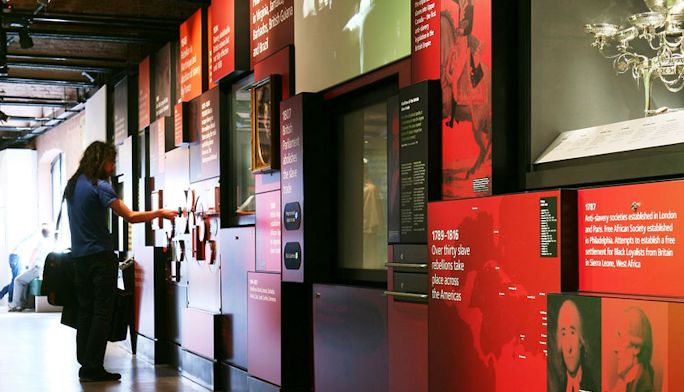Presented Past: Truth or Fabricated Opinion?
by Lyu Xiaoyan, Nagoya Umiversity
It has been a great experience for me to participate in the RENKEI PAX workshop. It is not the first time I was confronted with slavery history, yet it felt different when I stood in the International Slavery Museum and looked at the exhibits, showing the darkness of a long history. Liverpool is a city that is brave enough to embrace its past and have the courage to show it to the world. 
Image: Inside the International Slavery Museum, Liverpool
During our workshop we looked at a number of exhibitions and artistic works and they made me wonder: How should we present the past and the darkness within society? Should we take a side or just show the truth and leave the discussion to the audience? Who is in charge of choosing what is presented?
As mentioned above, the International Slavery Museum shows the dark past of the Transatlantic slave trade, in which the city of Liverpool played an important role. The exhibits display material evidence and memories from that time in a genuine and bold way without trying to hide away from what happened.
In contrast to this, I would like to introduce a Chinese movie, (The Story of an Abducted Woman) that tells a story of a woman abducted to a mountainous village and forced to marry to a man. Even when she had the chance to run away from the village, people around her persuaded her to stay for the sake of her children. In the end, she returned to the village and became a teacher and earned respect from the people there. Some of those who have watched the film feel insulted that a criminal act of human trafficking is fabricated into a story praising the woman’s submission and sacrifice to the perpetrator and the village. But the movie was based on a true story. Human trafficking cases in China often happen to women for the same reason described in the movie—to get married and give birth to children. This is not something from the past, it is happening now. In my view the interpretation of this sadly true story should be less concerned with looking good, and instead reveal the crime and raise awareness
Apart from the question of making right or wrong choices in presenting the past, mostly, the influence on the audience can be unintended. During the workshop, two exhibitions caught my eye. One was the exhibition of April Ashley, and the other one was Poppies: Women and War.
If you click on the April link, you will see the pictures of April in different life stages. It concerns me that the chosen pictures display her as a sexy woman wearing makeup and with feminine gestures, which to some extent is reinforcing gender stereotypes despite the fact that April is a remarkable transgender celebrity who could be an excellent figure to break the binary categories of gender.
In the example of the exhibition ‘Poppies: Women and War’ my reading of the text and portrayals is of women as victims. However, women fighting against the war should also be included in my point of view. After all, women contributed their efforts as well.
These two examples demonstrate the potential for displays to exert an unconscious influence on the audience. Moreover, nowadays in order to attract more attention to certain issues, many kinds of arts are being employed. Two online projects introduced in one of the PAX workshop sessions are the memory map and tejido.
The memory map is actually a very good way to link geographical locations with historical events. It connects present and the past. However, the lack of background information on the webpage can be a problem for people who may not be familiar with the history. As for the Tejido web, I actually felt confused and did not know what to do. And that is exactly what the designer wants users to feel: chaotic, powerless (which was later explained to us), although with a lack of explanation, the audience may not ever understand the meaning of it.
We often say that art is for everyone, but we should bear in mind that not everyone has the patience and knowledge to fully relate to artistic work. Getting more people to know and pay attention to certain issues is one of the aims of exhibitions, displays and other endeavors. Then again, how to present and what contents to present still remain to be answered.
The RENKEI PAX workshop opened discussion in many other ways over and above what I discussed here. What was new and valuable for me was to think in a deep way about ways to present the past and certain issues in society. However, my question is still there, and I hope with more exploration I can get an answer or at least a new perspective.